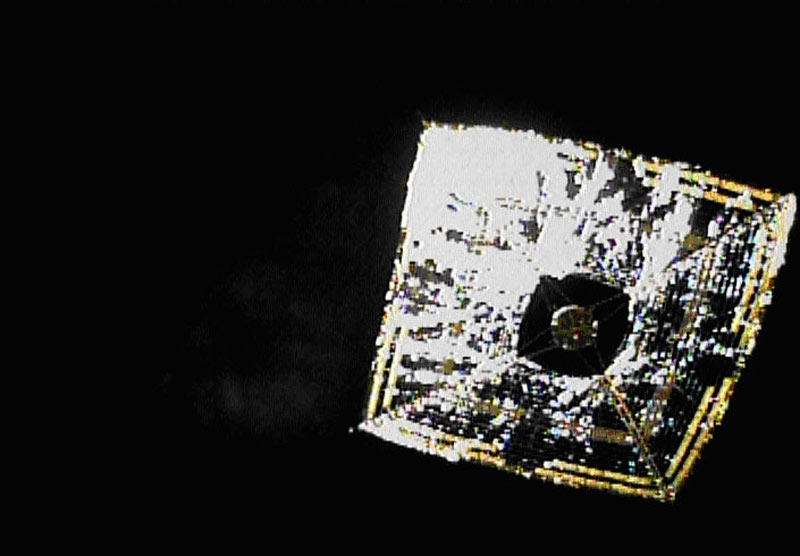Solar Sail Passes Big Test In Deep Space

An unmanned probe riding a solar sail through space hasfelt its first accelerating push from sunlight in a successful test of itsnovel propulsion system, Japan's space agency has announced.
Observations of the Ikarossolar sail built by the Japan Aerospace Exploration Agency (JAXA) confirmedthat the spacecraft has received a growing speed boost from light radiated bythe sun, the space agency said.
"The small solar power sail demonstrator 'Ikaros,'which successfully deployed its solar sail, was confirmed to accelerate by[the] solar sail receiving solar pressure," JAXA officials said in a July9 update.? "This proved that the Ikaros has generated the biggestacceleration through photon during interplanetary flight in history."
The effect stems from the cumulative push of lightphotons striking the solarsail. When measured together, it adds up to a small continuous thrust thatdoes not require fuel use by the Ikaros craft.
Sailing on light
JAXA engineers used Doppler radar measurements of the Ikaros craft todetermine that sunlight is pressing on the probe's solar sail with a force ofabout 1.12 millinewtons (0.0002 pounds of force).
"This is a significant milestone on their flight ?probably the next-to-last step before complete controlled solar sail flight isachieved (turning the spacecraft to add or subtract velocity in a controlledmanner)," wrote Louis Freidman, co-founder of the California-based Planetary Society, in a messagechronicling Ikaros' solar sailing success on the society's website.
Get the Space.com Newsletter
Breaking space news, the latest updates on rocket launches, skywatching events and more!
The Ikarosspacecraft weighs nearly 700 pounds (315 kg) has thin film solar cellsbuilt into its kite-like frame to generate electricity.
The square-shaped Ikaros sail measures 46 feet (14meters) wide and 66 feet (20 meters) diagonally. It is the first solar sail toactual fly on an interstellar mission.
Solar sail milestone
JAXA launched the solar sail Ikaros, short forInterplanetary Kite-craft Accelerated by Radiation Of the Sun, in May along withthe Venus-bound orbiter Akatsuki (Japanese for "Dawn"). The Akatsukiorbit is due to arrive at Venus in December.
The Planetary Society has been working to fly its ownsolar sail to demonstrate the space propulsion technology, as have NASAengineers. The Planetary Society is currently developing its next effort ? the LightSail1 mission ? using a spare NASAsolar sail. JAXA officials hope to follow Ikaros with an even moreambitious solar sailing mission, as well.
Friedman said scientists have long-known that photons oflight can push on spacecraft, but Ikaros is the first to attempt a true solarsailing flight.
"The acceleration by sunlight pressure on spacecrafthas been known about ever since the beginning of the space age. It is, however,a new proof of engineering ? harnessing the force of light pressure force tomodify a sailcraft's path in a controlled way," Friedman wrote.
- JapanAims for Venus, Part2
- World'sFirst Solar Sail Photographed in Deep Space
- HowDo Solar Sails Work?
Join our Space Forums to keep talking space on the latest missions, night sky and more! And if you have a news tip, correction or comment, let us know at: community@space.com.

Tariq is the Editor-in-Chief of Space.com and joined the team in 2001, first as an intern and staff writer, and later as an editor. He covers human spaceflight, exploration and space science, as well as skywatching and entertainment. He became Space.com's Managing Editor in 2009 and Editor-in-Chief in 2019. Before joining Space.com, Tariq was a staff reporter for The Los Angeles Times covering education and city beats in La Habra, Fullerton and Huntington Beach. In October 2022, Tariq received the Harry Kolcum Award for excellence in space reporting from the National Space Club Florida Committee. He is also an Eagle Scout (yes, he has the Space Exploration merit badge) and went to Space Camp four times as a kid and a fifth time as an adult. He has journalism degrees from the University of Southern California and New York University. You can find Tariq at Space.com and as the co-host to the This Week In Space podcast with space historian Rod Pyle on the TWiT network. To see his latest project, you can follow Tariq on Twitter @tariqjmalik.









